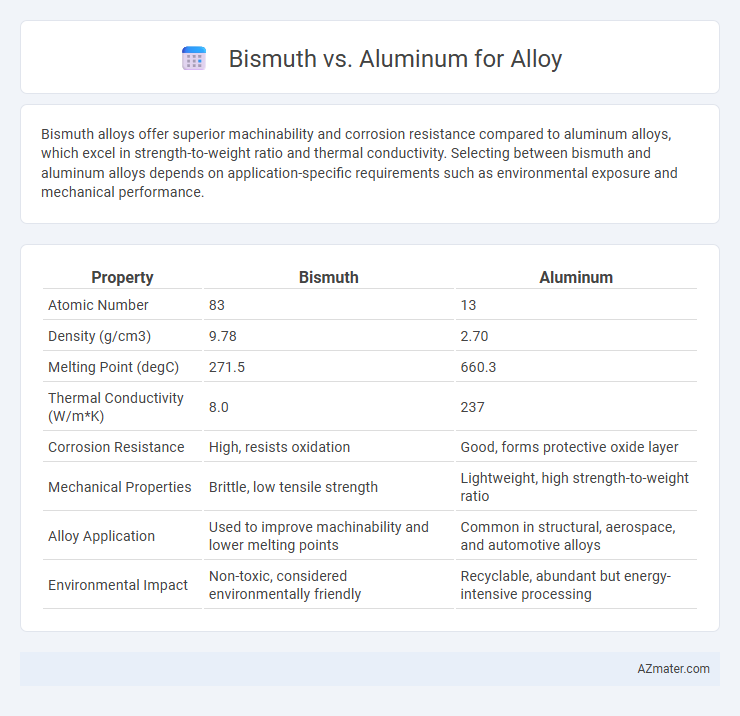Bismuth alloys offer superior machinability and corrosion resistance compared to aluminum alloys, which excel in strength-to-weight ratio and thermal conductivity. Selecting between bismuth and aluminum alloys depends on application-specific requirements such as environmental exposure and mechanical performance.
Table of Comparison
| Property | Bismuth | Aluminum |
|---|---|---|
| Atomic Number | 83 | 13 |
| Density (g/cm3) | 9.78 | 2.70 |
| Melting Point (degC) | 271.5 | 660.3 |
| Thermal Conductivity (W/m*K) | 8.0 | 237 |
| Corrosion Resistance | High, resists oxidation | Good, forms protective oxide layer |
| Mechanical Properties | Brittle, low tensile strength | Lightweight, high strength-to-weight ratio |
| Alloy Application | Used to improve machinability and lower melting points | Common in structural, aerospace, and automotive alloys |
| Environmental Impact | Non-toxic, considered environmentally friendly | Recyclable, abundant but energy-intensive processing |
Introduction to Bismuth and Aluminum in Alloys
Bismuth and aluminum are both critical elements used in alloy production, each offering unique properties that enhance material performance. Bismuth alloys are valued for their low toxicity, excellent machinability, and low melting points, making them ideal for applications requiring precision casting and environmentally friendly alternatives to lead. Aluminum alloys stand out due to their lightweight, high strength-to-weight ratio, excellent corrosion resistance, and electrical conductivity, widely used in automotive, aerospace, and construction industries.
Physical Properties Comparison
Bismuth exhibits a low melting point of 271.5degC and a high density of 9.78 g/cm3, making it significantly heavier than aluminum, which has a melting point of 660.3degC and density of 2.70 g/cm3. Bismuth's brittleness contrasts with aluminum's malleability and ductility, influencing their mechanical behavior in alloys. Thermal conductivity also differs, with aluminum displaying higher conductivity at around 237 W/m*K compared to bismuth's 8.7 W/m*K, impacting heat dissipation in alloy applications.
Melting Points and Casting Behavior
Bismuth has a melting point of 271.5degC, significantly lower than aluminum's melting point of 660.3degC, making bismuth-based alloys easier to cast at lower temperatures. Bismuth alloys exhibit minimal thermal expansion and excellent fluidity during casting, reducing porosity and resulting in precise, smooth castings. Aluminum alloys require higher temperatures and tend to have more shrinkage and porosity problems, but benefit from higher strength and thermal conductivity.
Mechanical Strength and Durability
Bismuth-aluminum alloys exhibit lower mechanical strength compared to traditional aluminum alloys due to bismuth's brittle nature, which tends to reduce ductility and tensile strength. Aluminum alloys generally offer superior durability and resistance to fatigue, making them more suitable for high-stress applications. The incorporation of bismuth primarily enhances machinability and corrosion resistance but compromises overall structural robustness.
Corrosion Resistance and Longevity
Bismuth alloys exhibit superior corrosion resistance compared to aluminum alloys, making them ideal for environments exposed to moisture and chemicals. Aluminum alloys tend to form protective oxide layers but can suffer from pitting and galvanic corrosion over time, reducing longevity. The use of bismuth in alloys enhances stability and durability, prolonging the lifespan of components in harsh conditions.
Environmental Impact and Toxicity
Bismuth alloys are favored over aluminum for applications requiring low environmental impact due to bismuth's non-toxic nature and recyclability, contrasting with aluminum, which demands high energy consumption and generates significant greenhouse gas emissions during production. Bismuth's low toxicity makes it safer for use in medical devices and consumer products, whereas aluminum exposure has been linked to neurotoxicity and environmental concerns such as soil and water contamination. The lifecycle analysis reveals bismuth alloys contribute less to ecological degradation and human health risks compared to aluminum alloys.
Cost and Availability
Bismuth is significantly more expensive and less abundant than aluminum, making it less favorable for large-scale alloy production. Aluminum offers cost efficiency due to its widespread availability and lower market price, which supports its extensive use in alloys for industries like automotive and aerospace. The scarcity and higher extraction costs of bismuth limit its application primarily to niche alloys requiring specific properties rather than bulk manufacturing.
Common Applications in Industry
Bismuth alloys are commonly used in low-melting applications such as fire detection devices, solders, and pharmaceuticals due to their non-toxic, environmentally friendly properties and high density. Aluminum alloys dominate the aerospace, automotive, and construction industries thanks to their excellent strength-to-weight ratio, corrosion resistance, and machinability. Both metals are vital in specialized industrial sectors, with bismuth preferred where non-toxicity and fusibility are critical and aluminum favored for structural components requiring durability and light weight.
Machinability and Workability
Bismuth alloys offer superior machinability due to their low melting point and ability to create free-machining characteristics, reducing tool wear and increasing precision in complex parts. Aluminum alloys provide excellent workability with high ductility and corrosion resistance, making them ideal for forming, bending, and welding processes. Bismuth promotes fine chip formation and minimizes burrs, while aluminum's lightweight nature and thermal conductivity enhance performance in aerospace and automotive applications.
Choosing the Right Metal for Alloying Purposes
Bismuth offers excellent low-melting point properties and environmentally friendly characteristics, making it ideal for alloys in applications requiring non-toxic and biodegradable materials. Aluminum provides superior strength-to-weight ratio, corrosion resistance, and thermal conductivity, making it a preferred choice for structural and aerospace alloys. Selecting the right metal depends on the alloy's functional requirements, balancing factors such as melting point, mechanical strength, and environmental impact.

Infographic: Bismuth vs Aluminum for Alloy
 azmater.com
azmater.com